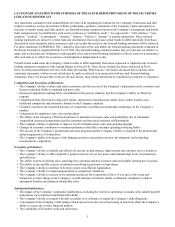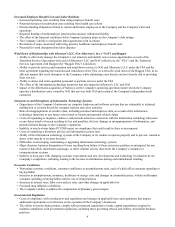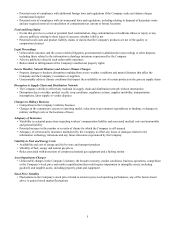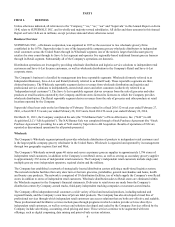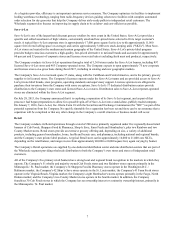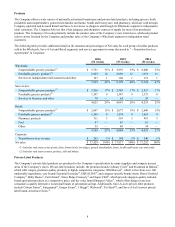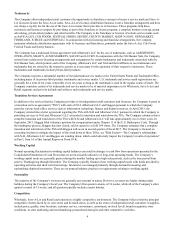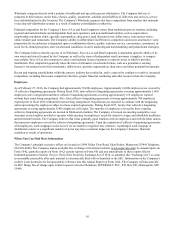Albertsons 2016 Annual Report Download - page 15
Download and view the complete annual report
Please find page 15 of the 2016 Albertsons annual report below. You can navigate through the pages in the report by either clicking on the pages listed below, or by using the keyword search tool below to find specific information within the annual report.13
distinguish themselves from competitors in the grocery channel. The Company’s Wholesale segment also faces competition
from retailers that maintain or develop self-distribution systems as a result of industry consolidation or otherwise. The inability
to attract new customers, the loss of existing customers to a competing wholesaler or due to closure, vertical integration such as
an existing customer converting to self-distribution, or industry consolidation, or the inability of the Company’s customers to
compete successfully with other grocery retailers and non-traditional retailers may negatively impact the Company’s sales and
gross margin.
The Company’s Retail and Save-A-Lot segments face significant competition for customers, managers, employees, store sites
and products from traditional grocery retailers, including regional and national chains and independent food store operators,
and non-traditional retailers, such as supercenters, membership warehouse clubs, specialty supermarkets, drug stores, discount
stores, dollar stores, convenience stores, online retailers and restaurants. Competitors continue to increase their presence in the
Company’s markets, including certain non-traditional competitors that have entered the grocery retailing business. The
Company’s ability to differentiate itself from its competitors and create an attractive value proposition for its customers is
dependent upon a combination of price, quality, customer service, convenience, assortment, in-stock levels, brand perception,
store location and conditions, in-store marketing and merchandising and promotional strategies. Any failure to positively
differentiate the Company’s stores, as well as the inability to identify and respond to changes in economic conditions and trends
in consumer preferences, could decrease the number of customer transactions at the Company’s stores and decrease the amount
customers spend when they visit the Company’s stores.
In addition, customers are increasingly using tablets, mobile phones, computers and other devices to shop in stores and online
and provide feedback and public commentary on their shopping experience, including prices. Multichannel retailing is rapidly
evolving. If the Company does not keep pace with changing customer expectations and new developments and technology
investments by its competitors, the Company’s ability to compete and results of operations could be adversely affected.
The Company may not be able to successfully identify and execute on initiatives to increase its sales and profits.
The Company’s ability to grow sales and profits depends on many factors, including its ability to attract new customers and
licensees throughout its existing network of distribution centers, political, social and economic conditions, and the Company’s
ability to successfully identify and execute on growth and profit-enhancing opportunities. The Company continuously
evaluates the changing business environments in which it operates and seeks out opportunities to improve performance,
customer service and growth through selected initiatives. The Company’s ability to execute on these initiatives is dependent, in
part, upon its ability to continue to provide a high level of customer service, offer competitive products at low prices, maintain
high levels of productivity, become a more cost-efficient organization and offer services that provide value. There are no
assurances that the Company will be able to identify the appropriate course of action, including which initiatives will be the
most effective in improving the competitive position or profitability of the Company, or that the Company will be able to
respond appropriately to competitors’ initiatives. If the Company is unable to execute on its initiatives, the Company’s financial
condition and results of operations may be adversely affected.
The Company may engage in acquisitions and divestitures, and may encounter difficulties integrating acquired
businesses with, or disposing of divested businesses from, the Company’s current operations; therefore, the Company
may not realize the anticipated benefits of these acquisitions and divestitures.
The Company may engage in strategic acquisitions. The Company’s due diligence reviews may not identify all of the material
issues necessary to accurately estimate the cost and potential loss contingencies of a particular transaction, including potential
exposure to regulatory sanctions resulting from an acquisition target’s previous activities. The Company may incur
unanticipated costs or expenses, including post-closing asset impairment charges, expenses associated with eliminating
duplicate facilities, litigation and other liabilities. The Company also may encounter difficulties in integrating acquisitions with
its operations, applying its internal controls processes to these acquisitions or in managing strategic investments. Additionally,
the Company may not realize the degree or timing of benefits it anticipates when it first enters into a transaction. Any of the
foregoing could materially adversely affect the Company’s competitive position, financial condition, operating results or cash
flows. Furthermore, the Company may make strategic divestitures from time to time. Any divestitures may result in continued
financial involvement in the divested businesses, such as through guarantees or other financial arrangements or continued
supply and services arrangements, following the transaction. Under these arrangements, non-performance by those divested
businesses could result in obligations imposed on the Company and could have an adverse effect on the Company’s competitive
position, financial condition, operating results or cash flows. The success of future acquisitions and divestitures will depend on
the satisfaction of conditions precedent to, and consummation of, the transactions, the timing of consummation of these
transactions and the ability of the parties to secure any required regulatory approvals in a timely manner, among other things.


